Gaming At 1920x1080: AMD's Trinity Takes On Intel HD Graphics
Think you're pretty snazzy because your integrated graphics core plays mainstream games at 1280x720? We're on to bigger and better things, like modern titles at 1920x1080. Can AMD's Trinity architecture push high-enough frame rates to make this possible?
Benchmark Results: World Of Warcraft
As usual in our WoW testing, we used Fraps to measure frame rates on an automated trip from Crushblow to The Krazzworks, changing graphics quality presets between flights and leaving MSAA at 1x.
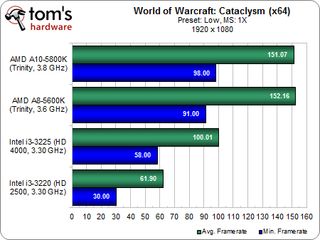
We saved some good news for last. The nine million or so WoW subscribers may be relieved to know that all four of our platforms can play their favorite MMORPG at low settings. Even the Core i3-3220 averages more than two times the average FPS requirement. The trick with WoW, though, is that the game adds a pretty sizable processing load as you step up the preset chain. This is obvious as you fly over the landscape. In Low settings, the trees are largely denuded and fog obscures a lot of ground detail. WoW reveals quite a bit even in stepping up to Medium detail.
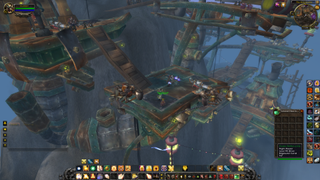

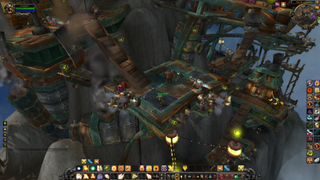
Again, WoW delivers the most visual punch in stepping from Low to Good settings. The vibrancy of scenes really pops as you lose a lot of that obscuring mist. Textures gain more depth and shadows more realism at higher settings, but if you only have enough overhead for one or two steps up the quality scale, AMD’s Trinity will get you there while the latest Core i3 chips will not.
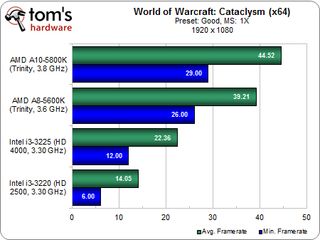
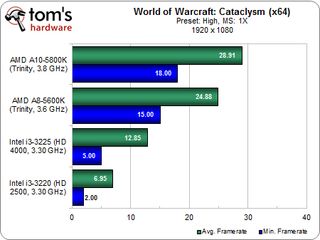
World of Warcraft's Good quality preset gives you the best balance of graphics quality and performance on AMD's A10-5800K. The High quality setting is just too demanding, particularly if you find yourself in busy raids.
Still, let’s not lose sight of the fact that all four of these chips deliver excellent playability at Low settings. If you’re more concerned about enjoying the game and its community and less worried about the look of it all, your barrier to entry in a high-def setting remains low.
Stay on the Cutting Edge
Join the experts who read Tom's Hardware for the inside track on enthusiast PC tech news — and have for over 25 years. We'll send breaking news and in-depth reviews of CPUs, GPUs, AI, maker hardware and more straight to your inbox.
Current page: Benchmark Results: World Of Warcraft
Prev Page Benchmark Results: Batman: Arkham City Next Page Second-Generation APUs: Playable, If You Compromise Detail-
azathoth Seems like a perfect combination for a Casual PC gamer, I'm just curious as to the price of the Trinity APU's.Reply -
luciferano They both have graphics that have HD in their name, but AMD's HD graphics are more *HD*, lol.Reply -
Nintendo Maniac 64 Err... did we really need both the A10-5800k and the A8-5600k? Seeing how both are already 100w unlocked CPUs, surely something like an A10-5800k vs a 65w A10-5700 would have been more interesting for an HTPC environment...Reply -
mayankleoboy1 Consoles set the bar for game developers. These iGPU's are comparable to the consoles and thats why games will run smooth here.Reply
With next gen consoles coming out next year, game devs will target them. Hence the minimum standard for games will rise, making the next gen games much slower on the iGPU's. So both AMD and Intel will have to increase performance much more in the next 1-2 years.
tl;dr : next gen games will run poorly on these igpu's as next gen consoles will set the minimum performance standard. -
mousseng Reply
Keep in mind, though, that that's exactly what's going to allow AMD and Intel to advance their hardware faster than games will, as they were discussing in the article (first page of the interview). Look how far Fusion and HD Graphics have come over the past 3 years, and look how long the previous console generation lasted - if that trend is anything to go by, I'm sure integrated graphics could easily become a viable budget gaming option in the next few years.9537609 said:tl;dr : next gen games will run poorly on these igpu's as next gen consoles will set the minimum performance standard. -
falchard Since when as AMD or nVidia actually taken on Intel graphics? Thats a bit insulting considering the disproportionate results time and time again.Reply -
luciferano mayankleoboy1Consoles set the bar for game developers. These iGPU's are comparable to the consoles and thats why games will run smooth here.With next gen consoles coming out next year, game devs will target them. Hence the minimum standard for games will rise, making the next gen games much slower on the iGPU's. So both AMD and Intel will have to increase performance much more in the next 1-2 years.tl;dr : next gen games will run poorly on these igpu's as next gen consoles will set the minimum performance standard.Reply
Actually, the A10 and A8 have somewhat superior graphics compared to current consoles. Current consoles can't even play in 720p as well as these AMD IGPs played 1080p despite being a more optimized platform, so that this is true is kinda obvious IMO. Also, new games would simply mean dropping resolution for these APUs. They wouldn't be unable to play new games, just probably at 1080p and 16xx by 900/10xx resolutions too.
Intel probably isn't very motivated by gaming performance for their IGPs and they're supposedly making roughly 100% performance gains per generation with their top-end IGPs anyway, so they're working on growing IGP performance. AMD also gets to use GCN in their next APU and I don't think that I need to explain the implications there, especially if they go the extra mile with using their high-density library tech too.
Most Popular

